In our March 2017 issue we include a diagram of all small, confirmed exoplanets in their stars’ habitable zones. Here’s the saga of how we decided which planets to put on that list.
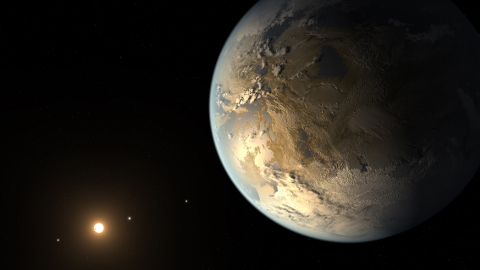
NASA Ames / SETI Institute / JPL-Caltech
Each feature article that appears in Sky & Telescope has what I like to call a shepherding editor. The shepherding editor not only edits the article’s text but also fact-checks it (major time sink) and hunts down or devises all the diagrams and illustrations that appear as part of the article. It can take as much work as writing the article itself.
I was shepherding editor for Shannon Hall’s lovely March 2017 cover story on super-Earths. Super-Earths are planets larger than Earth but smaller than Uranus and Neptune. There’s nothing like them in the solar system (as far as we know), yet they’re the most common type of planet discovered by NASA’s Kepler mission. Could they be habitable?
To visually support this question in the article, I wanted a diagram that shows how many potentially rocky exoplanets astronomers have discovered in their star’s putative habitable zones. A habitable zone is the narrow range of distances an Earth-like planet could be from its star such that the world is just the right temperature to sustain liquid water on its surface.
So I went looking for the latest tally of small, potentially habitable exoplanets. And I fell down a scientific rabbit hole.
Definition of a Habitable Zone
NASA’s Kepler team had released a diagram in May 2016 showing all the small, habitable-zone planets discovered by the spacecraft thus far. The diagram places exoplanets based on the energy they receive from their host star (x-axis) and how hot that star is (y-axis). It (supposedly) only includes planets that are about twice as wide as Earth or smaller. (I later determined a bigger planet, the 3.17-Earth-radii Kepler-1593b, had snuck into the list.)
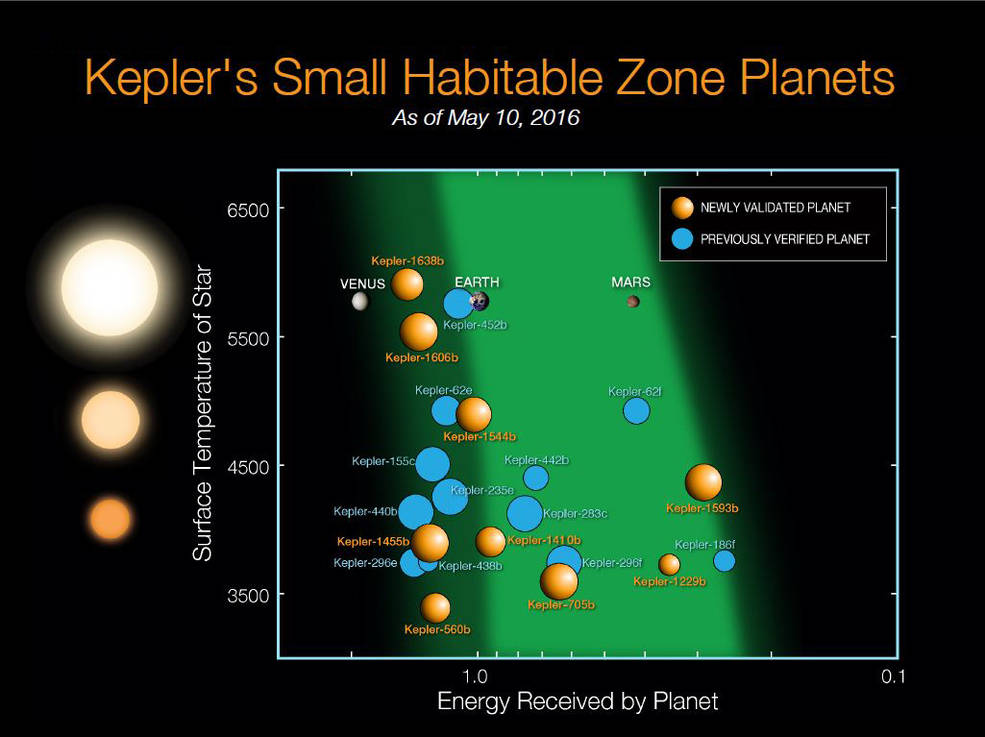
Meanwhile, I had found a similar, souped-up diagram on the Habitable Exoplanets Catalog (HEC) website, created by the folks at the Planetary Habitability Laboratory at the University of Puerto Rico, Arecibo. The diagram includes all exoplanets discovered in habitable zones, not just those spotted by Kepler. I also liked this diagram because its style told me the original version was a postscript file, which is much easier for our illustrator to work with. (Long story.) The fine print said the diagram was from August 2016.
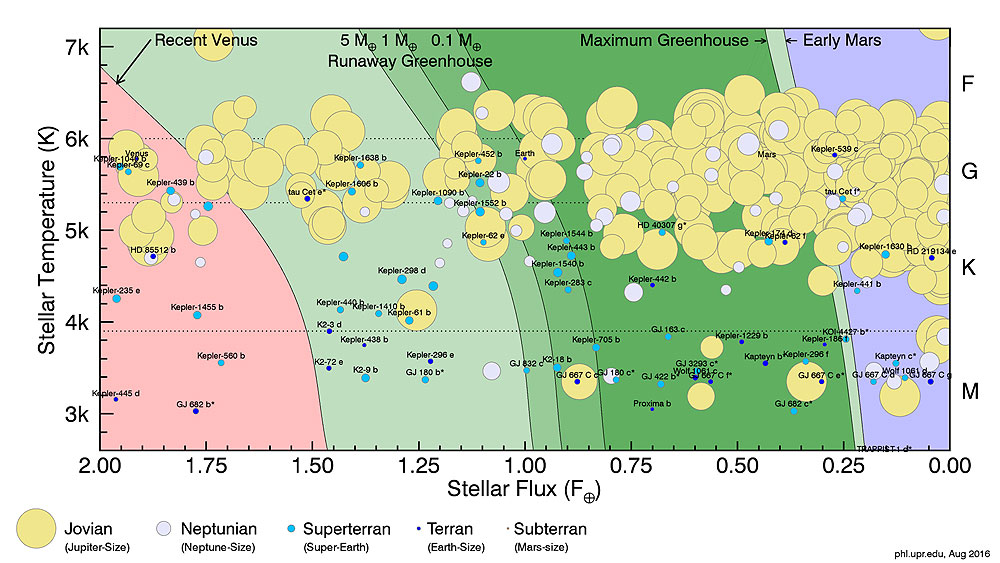
Both diagrams had a narrower, “conservative” habitable zone (bright green) and a wider, “optimistic” habitable zone. I didn’t know which was better for our purposes.
That left me with what I thought were two fairly straightforward questions: (1) was the HEC list the most up to date, or should we use something else? (2) what’s the difference between the optimistic and conservative habitable zones?
I reached out to the Kepler mission’s project scientist, Natalie Batalha (NASA Ames). A mission’s project scientist is basically the high mucky-muck that balances all the team’s scientific goals and serves as advocate for those priorities when it comes time to make decisions on what to spend time and money on. She told me the HEC was probably my best bet. (More on that shortly.)
But what was really cool was her reply to question #2. I had figured the only thing separating the optimistic and conservative HZs was how handwavy the assumptions were — and there’s a bunch of chatter these days in exoplanet circles about how nebulous the idea of a habitable zone is, so I wasn’t sanguine about the optimistic zone being realistic.
But in fact the optimistic HZ is empirical. Astronomers define its edges based on when liquid surface water last could have existed on Venus and Mars, Batalha explained:
Radar observations of Venus by Magellan indicate that Venus has not had water for at least 1 billion years. So, in the best-case scenario, it lost its water 1 billion years ago. A billion years ago, the Sun was slightly less luminous that it is today. Venus today receives 1.92 times the energy received by Earth. A billion years ago, Venus received 1.78 times the energy received by Earth. That sets the “optimistic” inner edge.
You can make a similar argument based on Mars. Assuming the dried-up river and lake beds on the Martian surface are 3.8 billion years old . . . we know that the Sun was 75% as bright back then . . . Today Mars receives 0.43 times as much energy as Earth. 3.8 billion years ago, Mars received 75% of that, or 0.32 times the energy Earth receives today. This sets the optimistic outer boundary.
The more conservative limits are based on climate modeling for a planet with an Earth-like mass and atmosphere. I should note, though, that many of the published results have not included cloud feedback in their models. This is why most people opt to use the empirical (or optimistic) limits.
Thus my skepticism about the optimistic HZ was not entirely merited. I decided to include both ranges in our chart.
One of These Diagrams is Not Like the Others
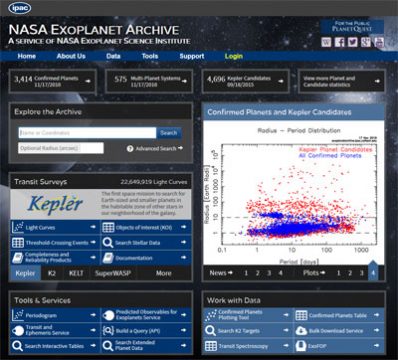 Meanwhile, I’d discovered that the NASA Exoplanet Archive — which records all the Kepler detections, both candidate and confirmed — also has a list of HZ planets. I decided to compare that list against the May 2016 release, to see if any were missing from the May list. I figured it’d be a straightforward way to see if that diagram needed updating. Five archive exoplanets were MIA from the May chart.
Meanwhile, I’d discovered that the NASA Exoplanet Archive — which records all the Kepler detections, both candidate and confirmed — also has a list of HZ planets. I decided to compare that list against the May 2016 release, to see if any were missing from the May list. I figured it’d be a straightforward way to see if that diagram needed updating. Five archive exoplanets were MIA from the May chart.
But it got worse: there were three on the May list (two, if you eliminate Kepler-1593b) that weren’t in the archive’s HZ list.
Batalha suspected that it might be a matter of which assumptions went into defining the HZ — for example, the amount of incoming radiation that defines the zone varies slightly depending on the type of star we’re dealing with, and the NASA archive doesn’t account for that. She offered to poke around if I sent her the lists.
Before e-mailing her the spreadsheet I’d compiled — which was looking fairly ugly at that point, with estimated sizes, orbital periods, temperatures, and other tidbits I’d extracted from the NASA archive — I decided to compare the Kepler worlds on the HEC list with those on the two NASA lists.
Those didn’t match, either.
Then I thought to do a sanity check. I took a planet that did appear on all three lists, looked up its insolation (how much sunlight it received from its star) in the NASA archive, then checked the HEC diagram to see if the planet was plotted where the NASA stats said it should be.
It wasn’t — it was way over to the left, receiving 45% more radiation than the NASA list claimed (excluding error bars).
I felt like I was trapped in a maze, running around desperately looking for the exit while the timer (a.k.a. my deadline) was counting down.
Keep Calm and Don’t Expect Precision
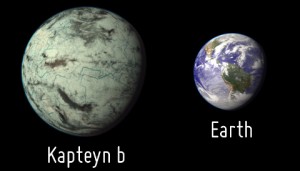
Planetary Habitability Laboratory
I’d already been in contact with the Planetary Habitability Lab’s director, Abel Méndez, to obtain the HEC diagram. I shot him another e-mail, explaining my quandary and asking him how his team decided which habitable-zone Kepler worlds to include in the diagram and where to put them.
He explained that his team considers a Kepler planet as potentially habitable if it meets two criteria: (1) its radius is less than 2.5 Earth radii (1.5 Earth radii being conservative), and (2) the planet's orbit is within the optimistic HZ, calculated based on the particular star’s properties, unlike the NASA archive.
He then added the following consoling paragraphs:
You will find different results in the NASA catalogs, and others, because they are based on different analysis or updates on the stellar properties, which affect the planet parameters. That’s one of the reasons why we include planets up to 2.5 Earth radii: those planets could be below 2.0 Earth radii under other assumptions. This is still a very imprecise science.
The solution is to (1) report your selection of planets based on a specific catalog and emphasize so in the description, or (2) combine the catalogs, check the papers, ask the individual discoverers on the best estimates, and compute each individual case. Number 2 is what we do and it is a full time job. Welcome to “exoplanet hell.”
I sat at my desk for several minutes in a swoon of relief. Literally: I think I might have been laughing hysterically. For nearly a week my frustration and confusion had been building, as I became convinced that something — goodness knows what — had gone dreadfully wrong. I despaired of my ability to do my job. Instead, I was just giving myself a taste of what professional astronomers deal with every day. Nothing was wrong. It’s just science.
Knowing what I now knew about the effort behind the HEC’s diagram (and knowing that the Kepler project scientist had given it a thumb’s up, too), I felt confident in using that list of habitable-zone planets.
And that’s how this diagram wound up in our magazine.
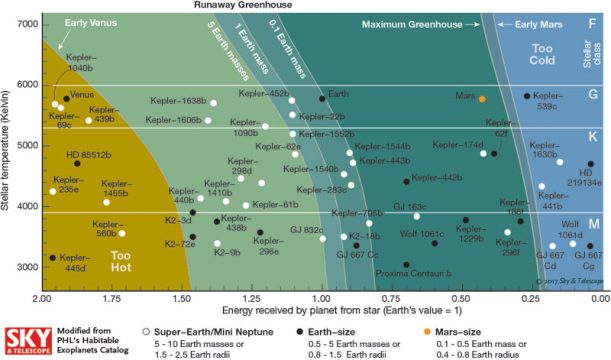
Sky & Telescope, source: Planetary Habitability Lab
Read Shannon Hall's cover story in our March 2017 issue, available in our online store.
 4
4

Comments
Richard-Lighthill
February 23, 2017 at 10:59 am
Thanks for your effort to be more objective than some in the "overly optimistic" science community and certainly more than those in the media.
As it relates to NASA's recent "7 planets" announcement, one item that I thought was overlooked is the issue of the possibility of water and life on a tidally locked planet (even within the "habitable zone") which the report stated was highly likely.
If a planet is indeed tidally locked isn't it unlikely that life-sustaining water (and it would likely need to be an ocean, not a pond or a chunk of ice) could even exist given that such a planet would be unable to sustain a global atmosphere (too hot on one side, and more than frigid on the other)?
You must be logged in to post a comment.
Tom-Fleming
February 23, 2017 at 8:03 pm
Thanks to Isaac Asimov and other S-F writers, I had always thought of the ribbon worlds as being too hot and too cold with the habitable zone right at the sunrise point. But what if we look at the sunlit side as a traditional target pasted onto a sphere with the bulls eye under the Solar Zenith? Were the planet placed at the further edge of the HZ, then the temperate portion would be one of the bulls eye rings placed at some distance from the Solar Zenithal point but not pushed all the way to the terminator. Differential heating would produce some atmospheric mixing. Certainly this would be a much more stable climate than the Earth's which may or may not not be a good thing from an evolutionary standpoint. I've glossed over many complexities that I cannot address...... but so did Asimov 🙂
You must be logged in to post a comment.
Louis d Hendecourt
February 24, 2017 at 8:46 am
The notion of "habitabilit" is awfully vague. First, from a simple and intuitive fact: if a planet is considered as "habitable" then it should necessarily be inhabited otherwise this would mean that the planet is not habitable. Second, defining a zone as it is done (a zone where water is liquid) is quite arbitrary. Our Moon stands in the habitable zone and honestly it seems difficult to only imagine we have life on the Moon. The same appears to be true for Mars where the least than you can say is that this planet does not vibrate with life. Recently, some evidence for deep liquid water on satellites of Jupiter, Saturn or even on Pluto really questions this notion of habitability even further. Indeed these objects are not in the habitable zone of the Sun and yet press releases from NASA always insist for a high probability that life has developped on these worlds (even if it is totally impossible to have even an order of magnitude figure on this probability, something that press releases never discuss).
So far so good. The difficulty in defining this "habitability" is actually simple to grasp: we have no idea how the transition from the inert state to the living one has emerged on our planet. We don't even know if this "emergence" is the result of a deterministic law or a result of sheer luck (a random possibility).
Then, they are so many contingencies in the emergence of life (as we konw it on Earth) that it is extremely hard (or even impossible?) to define a zone. On Earth, emerging life has taken advantage of the presence of liquid water, organic chemistry and, in my view, free energy from UV-Visible photons from the Sun and these three items had to be present at the same time. Organic chemistry is at the basis of molecular biology, water is at the basis of chemical reactivity for reactants to react and light is necessary for activating the building blocks of life in order to make "walls" and not only bricks. But on top of that you need some long term stability for chemical networks to function towards self-organization (the definition of minimum life). So the environment should be stable. A magnetic field has been necessary to prevent the atmosphere to escape the Earth (by cosmic ray ionization and escape) so as it seems to have been the case for Mars.
Then biological evolution per itself is a very very long process (it took 3.5 Byrs of evolution to start having multicellular life, plants and animals) which means that the whole system must be globally pretty stable. The planet evolution might be deadly for a planet like it has been for Venus and Mars. Yet both planets and the Earth have been formed not so far from each other, at the same time and out of the (almost) same material. Yet only Earth has remained "habitable" (in part also because it was inhabited as we know that retroaction from biological evolution is also a factor of planetary evolution).
For example for these seven planets, we already have some ideas that the flux of hard X rays is quite important. What will be the effect on their (possible) atmosphere?. May be none of them are habitable then? that is not at all impossible.
Clearly to me, instead of habitability, we should invent a neologism such as "chemicability" meaning: do we have planetary conditions which offer the possibility of development of molecular networks a pre-requisite for abiogenesis and further prebiotic chemistry?
Clearly also, the point should be made that we need experimental work in this domain in order to sustain claims for "chemicability" and may be further on "habitability".
You must be logged in to post a comment.
Dave
February 24, 2017 at 7:54 pm
I think you're over-thinking this. An uninhabited planet does not necessarily mean it is uninhabitable. I agree that defining a "habitable" zone as that having liquid water, is arbitrary, or at best narrowly focused. This is based only on our knowledge of life on our planet. There may be other life forms that do not need water. Or oxygen. Or 20 degrees. Or whatever. Anyway, in my opinion, what they are saying is that planets in the "habitable zone" COULD support life as we know it, not that it DOES. There are a LOT of variables involved in supporting life, and they (NASA, etc.) have picked just a couple of the important ones.
You must be logged in to post a comment.
You must be logged in to post a comment.